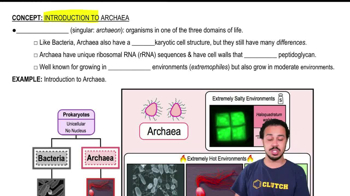Table of contents
- 1. Introduction to Biology2h 42m
- 2. Chemistry3h 40m
- 3. Water1h 26m
- 4. Biomolecules2h 23m
- 5. Cell Components2h 26m
- 6. The Membrane2h 31m
- 7. Energy and Metabolism2h 0m
- 8. Respiration2h 40m
- 9. Photosynthesis2h 49m
- 10. Cell Signaling59m
- 11. Cell Division2h 47m
- 12. Meiosis2h 0m
- 13. Mendelian Genetics4h 44m
- Introduction to Mendel's Experiments7m
- Genotype vs. Phenotype17m
- Punnett Squares13m
- Mendel's Experiments26m
- Mendel's Laws18m
- Monohybrid Crosses19m
- Test Crosses14m
- Dihybrid Crosses20m
- Punnett Square Probability26m
- Incomplete Dominance vs. Codominance20m
- Epistasis7m
- Non-Mendelian Genetics12m
- Pedigrees6m
- Autosomal Inheritance21m
- Sex-Linked Inheritance43m
- X-Inactivation9m
- 14. DNA Synthesis2h 27m
- 15. Gene Expression3h 20m
- 16. Regulation of Expression3h 31m
- Introduction to Regulation of Gene Expression13m
- Prokaryotic Gene Regulation via Operons27m
- The Lac Operon21m
- Glucose's Impact on Lac Operon25m
- The Trp Operon20m
- Review of the Lac Operon & Trp Operon11m
- Introduction to Eukaryotic Gene Regulation9m
- Eukaryotic Chromatin Modifications16m
- Eukaryotic Transcriptional Control22m
- Eukaryotic Post-Transcriptional Regulation28m
- Eukaryotic Post-Translational Regulation13m
- 17. Viruses37m
- 18. Biotechnology2h 58m
- 19. Genomics17m
- 20. Development1h 5m
- 21. Evolution3h 1m
- 22. Evolution of Populations3h 52m
- 23. Speciation1h 37m
- 24. History of Life on Earth2h 6m
- 25. Phylogeny2h 31m
- 26. Prokaryotes4h 59m
- 27. Protists1h 12m
- 28. Plants1h 22m
- 29. Fungi36m
- 30. Overview of Animals34m
- 31. Invertebrates1h 2m
- 32. Vertebrates50m
- 33. Plant Anatomy1h 3m
- 34. Vascular Plant Transport1h 2m
- 35. Soil37m
- 36. Plant Reproduction47m
- 37. Plant Sensation and Response1h 9m
- 38. Animal Form and Function1h 19m
- 39. Digestive System1h 10m
- 40. Circulatory System1h 57m
- 41. Immune System1h 12m
- 42. Osmoregulation and Excretion50m
- 43. Endocrine System1h 4m
- 44. Animal Reproduction1h 2m
- 45. Nervous System1h 55m
- 46. Sensory Systems46m
- 47. Muscle Systems23m
- 48. Ecology3h 11m
- Introduction to Ecology20m
- Biogeography14m
- Earth's Climate Patterns50m
- Introduction to Terrestrial Biomes10m
- Terrestrial Biomes: Near Equator13m
- Terrestrial Biomes: Temperate Regions10m
- Terrestrial Biomes: Northern Regions15m
- Introduction to Aquatic Biomes27m
- Freshwater Aquatic Biomes14m
- Marine Aquatic Biomes13m
- 49. Animal Behavior28m
- 50. Population Ecology3h 41m
- Introduction to Population Ecology28m
- Population Sampling Methods23m
- Life History12m
- Population Demography17m
- Factors Limiting Population Growth14m
- Introduction to Population Growth Models22m
- Linear Population Growth6m
- Exponential Population Growth29m
- Logistic Population Growth32m
- r/K Selection10m
- The Human Population22m
- 51. Community Ecology2h 46m
- Introduction to Community Ecology2m
- Introduction to Community Interactions9m
- Community Interactions: Competition (-/-)38m
- Community Interactions: Exploitation (+/-)23m
- Community Interactions: Mutualism (+/+) & Commensalism (+/0)9m
- Community Structure35m
- Community Dynamics26m
- Geographic Impact on Communities21m
- 52. Ecosystems2h 36m
- 53. Conservation Biology24m
26. Prokaryotes
Prokaryotic Diversity
Problem 3`
Textbook Question
Which of the following statements is not true?
a. Archaea and bacteria have different membrane lipids.
b. The cell walls of archaea lack peptidoglycan.
c. Only bacteria have histones associated with DNA.
d. Only some archaea use CO2 to oxidize H2, releasing methane.
 Verified step by step guidance
Verified step by step guidance1
Step 1: Understand the characteristics of Archaea and Bacteria. Archaea and bacteria are both prokaryotes, but they have distinct differences in their cellular structures and biochemical processes.
Step 2: Analyze statement (a): 'Archaea and bacteria have different membrane lipids.' Archaea have unique ether-linked lipids in their membranes, while bacteria have ester-linked lipids. This statement is true.
Step 3: Analyze statement (b): 'The cell walls of archaea lack peptidoglycan.' Archaea do not have peptidoglycan in their cell walls; instead, they have pseudopeptidoglycan or other polymers. This statement is true.
Step 4: Analyze statement (c): 'Only bacteria have histones associated with DNA.' Histones are proteins associated with DNA in eukaryotes and some archaea, not bacteria. This statement is not true because some archaea also have histones.
Step 5: Analyze statement (d): 'Only some archaea use CO2 to oxidize H2, releasing methane.' This describes methanogenesis, a process unique to some archaea. This statement is true.
 Verified video answer for a similar problem:
Verified video answer for a similar problem:This video solution was recommended by our tutors as helpful for the problem above
Video duration:
1mPlay a video:
Was this helpful?
Key Concepts
Here are the essential concepts you must grasp in order to answer the question correctly.
Membrane Lipids in Archaea and Bacteria
Archaea and bacteria have distinct membrane lipid compositions. Archaea possess ether-linked lipids, which are more stable in extreme conditions, while bacteria have ester-linked lipids. This difference is crucial for their adaptation to various environments and is a key factor in distinguishing these two domains of life.
Recommended video:
Guided course

Lipids
Cell Wall Composition in Archaea
The cell walls of archaea are unique in that they lack peptidoglycan, a polymer found in bacterial cell walls. Instead, archaea may have pseudopeptidoglycan or other polymers, which provide structural support and protection. This distinction is important for understanding the evolutionary divergence between archaea and bacteria.
Recommended video:
Guided course

Introduction to Bacterial Cell Walls
Histones in Archaea and Bacteria
Histones are proteins associated with DNA packaging in eukaryotes, and some archaea also have histone-like proteins. However, bacteria generally do not have histones; instead, they use other proteins for DNA organization. This concept is essential for understanding the differences in genetic material organization between these two groups.
Recommended video:
Guided course

Introduction to Archaea
Related Videos
Related Practice













